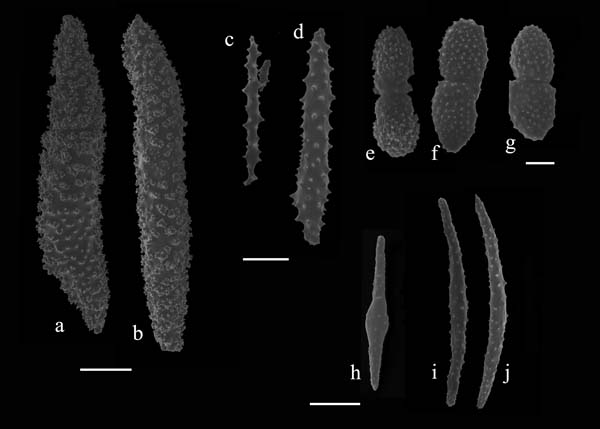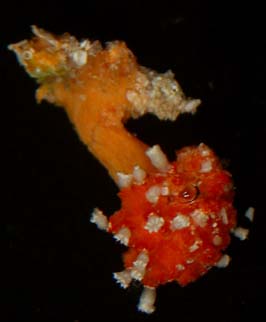CONTENTS
Introduction
The South Atlantic Bight
Methods
Octocoral Morphology
Glossary
Gorgonacean
Bauplan
see this for keys
Notes on the Species
Carijoa
riisei
Scleranthelia
rugosa
Telesto fruticulosa
Telesto nelleae
Telesto sanguinea
Bellonella rubistella
Pseudodrifa nigra
Nidalia occidentalis
Iciligorgia schrammi
Diodogorgia
nodulifera
Titanideum
frauenfeldii
Muricea pendula
Thesea nivea
Bebryce cinerea
Bebryce parastellata
Scleracis guadalupensis
Paramuricea sp.
Leptogorgia hebes
Leptogorgia punicea
Leptogorgia
cardinalis
Leptogorgia virgulata
Leptogorgia setacea
Leptogorgia euryale
Viminella
barbadensis
Renilla reniformis
Sclerobelemnon
theseus
Stylatula elegans
Virgularia presbytes
| Guide
to the Shallow Water (0-200 m) Octocorals of the South Atlantic
Bight.
S. T. DeVictor
& S. L. Morton, 2007
Nidalia occidentalis
Gray, 1935 Remarks. Nidalia occidentalis is easily distinguishable from other octocorals in the SAB by its stiff, barren stalk and capitate head bearing the monomorphic polyps and conical calyces. The stalk bears large (up to 1 mm), slightly curved, tuberculated spindles while the anthocodiae contain smaller needle-like rods in a collaret and points arrangement, and small flat platelets. The large spindles are six times longer than wide, a feature that distinguishes N. occidentalis from N. rigida, which bears thicker spindles. In life, one SERTC Nidalia occidentalis specimen had an orange stalk and red terminus bearing white polyps. In the preserved state the colors are slightly duller. The examined specimens reach 20 mm in length. Atlantic distribution: North Carolina to French Guiana, Gulf of Mexico, Caribbean, 37-440 m (one record off Venezuela indicates collection from 914 m) (Deichmann, 1936; Bayer, 1961; Verseveldt, 1978; NMNH collections; SERTC collection). |
|
 Figure 2. Nidalia occidentalis (S1384) sclerites. a, b) large spindles from capitulum (scale bar = 200 µm); c, d) small spindles from capitulum (scale bar = 100 µm); e-f) small platelets from calyx and anthocodia (scale bar = 20 µm); h-j) needles from polyp (scale bar = 100 µm). |
|
 |
